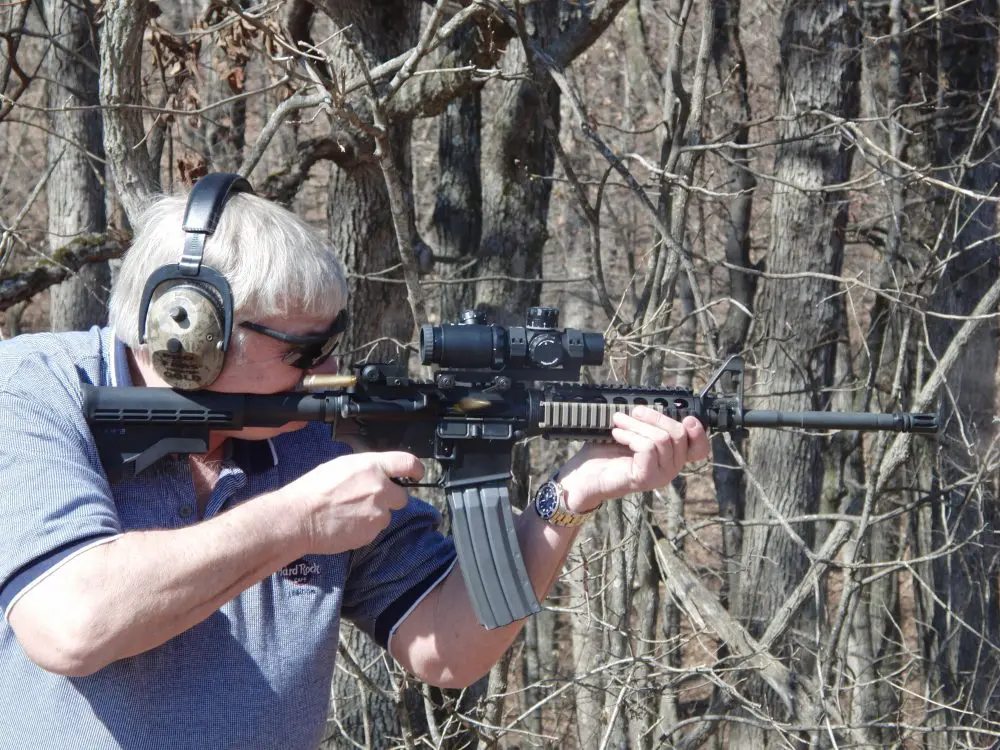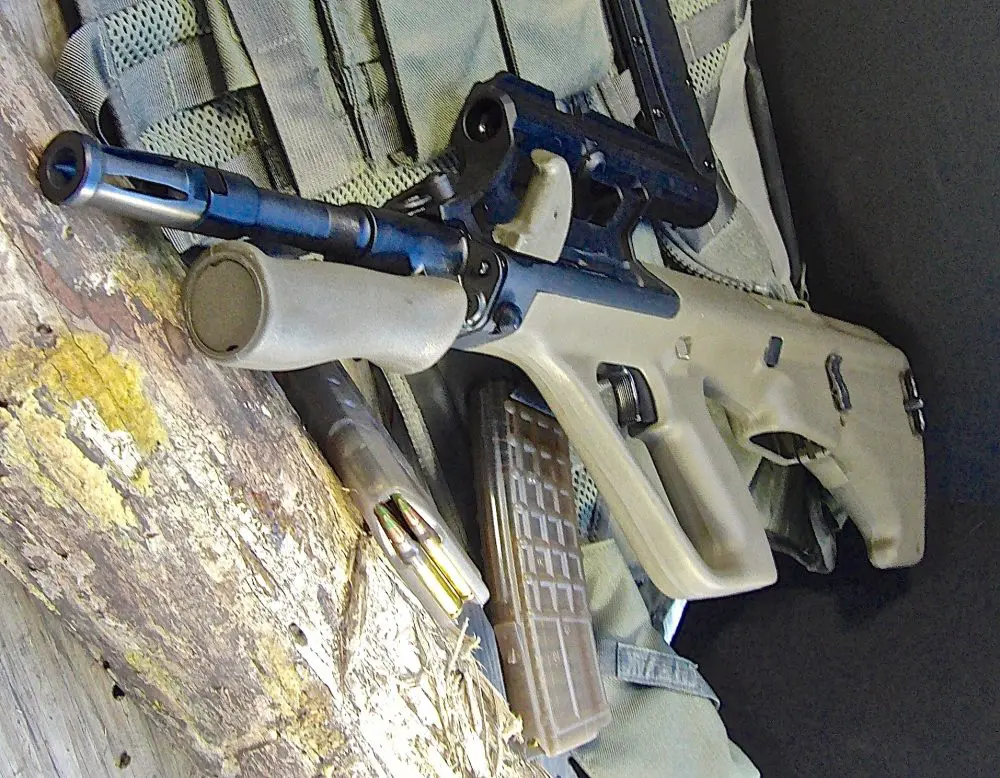
After nearly 50 years of hard combat use, the effectiveness of the 5.56mm cartridge is well established. Out to its mechanical limits, this high-velocity .22-caliber round is a known quantity on the battlefield.
However, in the open mountainous terrain of Afghanistan, the 5.56mm round fired from our standard M4 carbines sporting 14.5-inch barrels was found to be lacking. Insurgents firing heavy .30-caliber weapons outgunned our soldiers at extreme ranges. The solution to this problem was found gathering dust in warehouses and military storage depots here in the States.
The M14 only served as our first-line infantry rifle for about a decade back in the late 1950s and early 1960s. Firing the hard-hitting 7.62x51mm round from a 20-round removable box magazine, the M14 had the needed attributes of reliability and effectiveness at extreme ranges.
When coupled with a telescopic sight of modest magnification, this system was deemed a Designated Marksman Rifle (DMR) and ably filled the gap between lightweight, shorterranged 5.56mm weapons and dedicated sniper platforms.

While the resurrection of the esteemed M14 was a lamentably rare example of government developing a cost-effective solution out of existing equipment, the DMR concept is not as new as we might be led to believe.
More than half a century ago, Nazi Germany was locked in a desperate—but doomed—fight for survival on a battlefield that frequently facilitated long-range engagements. It was under these remarkably dark circumstances that German wartime engineers developed a weapon that bore an uncanny resemblance to today’s DMR.


Table of Contents
K43 ORIGINS
For all their indisputable depravity, the Germans had an extraordinary track record of military innovation. At a time when their nation was being inexorably strangled on two fronts and their industry subjected to aroundthe- clock strategic bombing, the Germans were developing weapons the influence of which is felt even today.
Today’s lightweight assault rifle, strategic ballistic missiles, jet-powered tactical aircraft, and the contemporary combat submarine all had their genesis with the Germans in World War II.
HITLER’S DMR
The standard Infantry rifle for the German Wehrmacht in 1939 was the venerable Mauser Kar98k, a bolt-action design firing a full-sized 7.92x57mm cartridge from an internal five-round magazine. When faced with the American M1 Garand and the Soviet SVT self-loading semiautomatic rifles, Hitler demanded a battle rifle that provided more firepower for a given weight for the individual German infantryman or grenadier.
The first solution was the Gewehr-41, a gas-trap design that was modestly successful. After combat trials on the Eastern front with G-41 variants produced by both Walther and Mauser, the design was simplified for reliability and mass produced as the G-43.
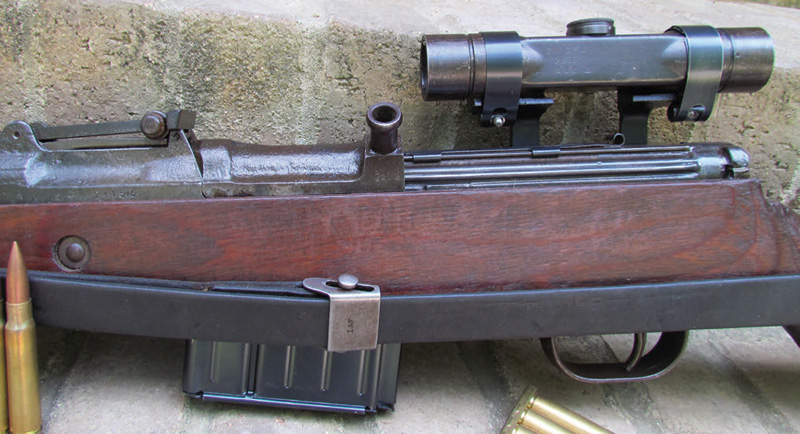
The G-43 incorporates the gaspiston system of the Russian SVT as well as the bolt-locking system of the Degtyaryov machine gun. The G-43 locks by means of a pair of pivoting steel wings that cam into recesses in the receiver. The resulting action is both smooth and strong. The Combloc RPD light machine gun incorporates a similar design.
As the war progressed, the G-43 design was steadily tweaked and adjusted to enhance ease of production. Eventually the rifle was rechristened the K-43 by Hitler himself, though the K-43 and G-43 rifles are essentially identical. What really set the system apart was the optics.

EARLY COMBAT GLASS
Early in the war, German engineers produced a long-eye-relief 1.5X scope for the Kar98k that mounted at the rear sight and was designed to be used with both eyes open. Not just fabulously successful, this concept was groundbreaking. It became obvious in practical usage that a rifleman armed with a low-power telescopic sight was markedly more effective at modest ranges than a comparable soldier shooting over iron sights. The U.S. Army came to the same conclusion 60 years later. The result of practical testing was the Gewehr-Zielfernrohr 4-fach, or ZF4 universal four-power telescopic sighting system.
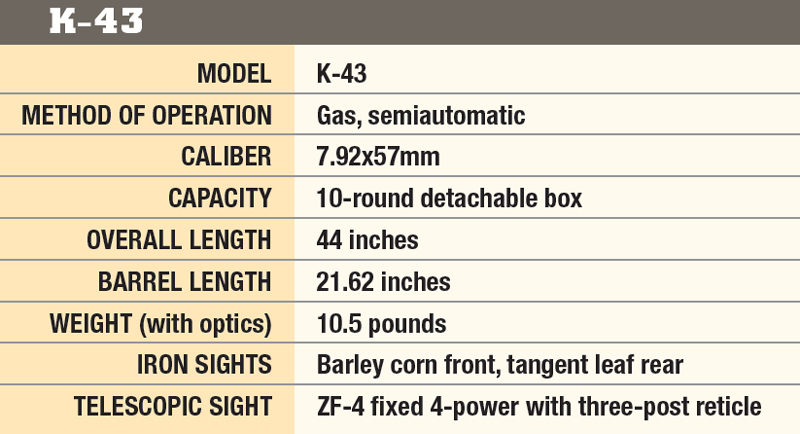
The ZF4 was a marvel of martial engineering. The scope body is a simple drawn tube and the three-post reticle incorporated into most of them was easy to use and effective. By standardizing a single mounting rail, the same telescopic sight could be used on the Kar98k Infantry rifle, the StG-44 assault rifle, the FG-42 paratroop rifle, and the G/K-43.
Several companies produced the ZF4. Many of the most commonly encountered versions were produced by slave labor in occupied Czechoslovakia. A contemporary copy is in production even today. When mated with the G/K-43 rifle, the ZF4 made for a system remarkably similar to today’s DMR.
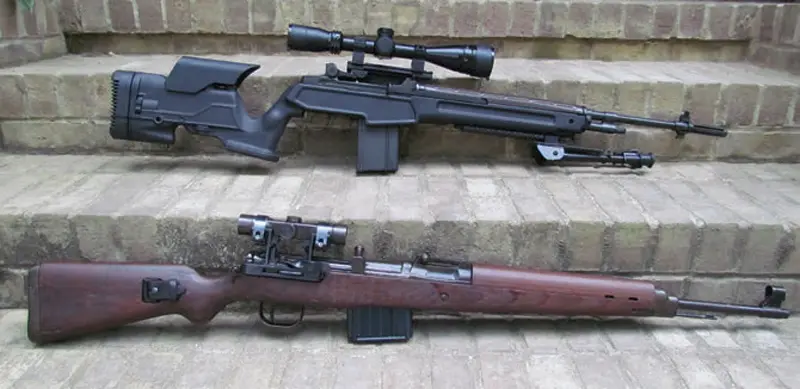
AT THE RANGE
The K-43 used in this evaluation was made by Walther and rolled off the assembly line in 1945. While the magazine is an aftermarket copy, the rest of the rifle is original and in remarkably good condition. The glass on the optical sight is still fairly clear, and the adjustments are all intact and functional. All testing was done using 1970s-era 7.92x57mm ball ammunition of questionable parentage.
Using a contemporary Springfield Armory M-1A as a control, the K-43 held its own with ease. The side-mounted sling on the German rifle is more practically useful than the parade-ground variant on the M-1A. The ZF4 scope produces an uncluttered field of view, and the fixed 4X magnification is about perfect for short- to mid-range engagements.
The bolt locks to the rear on the last round fired, and the charging handle is fixed to the bolt carrier and mounted on the left side. As a result, magazine changes are fast and intuitive. The magazine can be exchanged and the bolt released without taking the right hand off its firing position on the stock.
The only real downside I found to the K-43 was the trigger, which was remarkably long and creepy. In practical usage in rapid fire, this is not a big deal, but care must be taken to work the trigger appropriately for precision applications.

INSPIRATIONS
There is a reason that Nazis make the best movie villains of all time. They were some of the most racist megalomaniacs the planet has ever seen. Their twisted dreams of world conquest were crushed only after 50 million lives had been lost on all sides. But out of the detritus of World War II arose some of the most remarkable military technological advances of modern times.
The Kar98k is the classic, the StG-44 assault rifle gets all the press even today, and the FG-42 paratroop rifle is the golden ring for advanced gun collectors everywhere. As a result, it’s easy to view the G/K-43 as Hitler’s attempt to attain parity with the M1 Garand and call it a day. But when equipped with the groundbreaking ZF4 tactical scope, the G/K-43 becomes much more than that.
When compared with the M14, FNFAL, and AR-10, the scope-equipped K-43 could provide competitive service on contemporary battlefields as a Designated Marksman Rifle even today.


